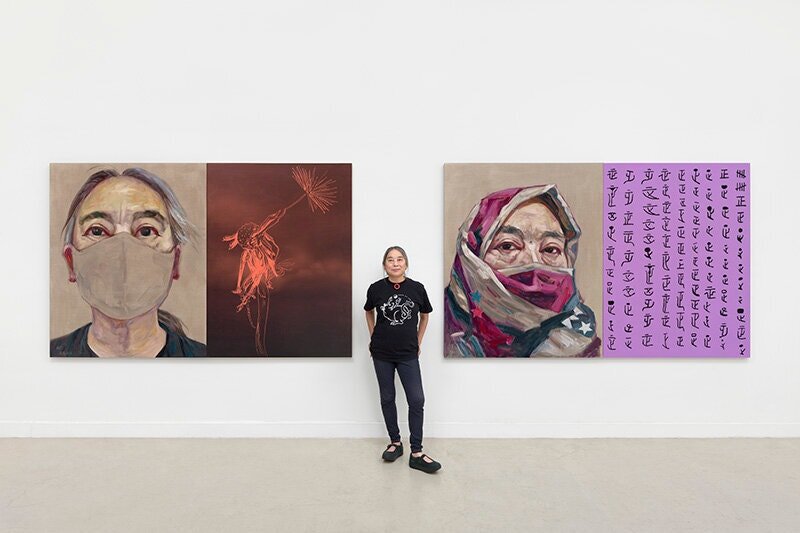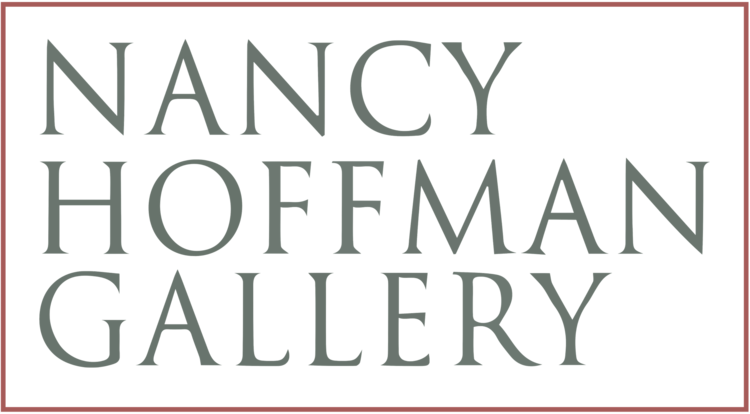Read MoreWhen the Chinese-American artist Hung Liu was asked to describe her creative process, she spoke about airplanes. Specifically, the long flights where she would study historical photographs, absorbing the details and textures of the images that would serve as the basis for her large-scale paintings. The subjects of these photos were often those she described as “spirit-ghosts” — orphans, migrants, refugees, and comfort women, from 19th century China to the American Dust Bowl. Her art honors history’s forgotten.
Hung Liu
Hung Lius “China Mary,” 2006, oil on canvas.
A Chinese legacy in the West →
Closing Sept. 30 is “Hung Liu and Rene Yung, The Vanishing: Re-presenting the Chinese in the American West,” an exhibition that melds two touring shows and offers multiple perspectives on a nearly forgotten aspect of Western history.
While most people probably have some vague knowledge that Chinese immigrants played a role in this country’s Western expansion, the depth of their involvement will likely surprise most viewers.
Read MoreHung Liu Portraits of Promised Lands

Unveiled on August 27,2021, just weeks after the passing of Hung Liu from pancreatic cancer, “Portraits of Promised Lands” was not just a highly anticipated celebration of the artist’s career of five decades, but a vital opportunity for insights into Liu’s life and artistic concerns, including issues of identity.
Read MoreForbes: Hung Liu’s Crying Canvases Reframe Immigration Stories At Smithsonian National Portrait Gallery →

Hung Liu’s Crying Canvases Reframe Immigration Stories At Smithsonian National Portrait Gallery
Chadd Scott Contributor
The popular American immigration fantasy focuses on the positive. On the receiving end. On America’s welcoming arms for “your tired, your poor, your huddled masses yearning to breathe free.” Horatio Alger success stories.
This conversation positions migrants as eager American citizens starting exciting new lives, not as people with full–and generally tragic–histories before wanting–and generally needing–to uproot themselves and go to America.
Immigrants dating all the way back to the European colonizers of North America didn’t pull up stakes to try making a new life here because it was their preferred option. They were forced to leave by religious persecution, famine, poverty, plagues, war, natural disasters–traumas. Precious few people choose to dislocate themselves and their families from their homes to roll the dice on a new life in a country where they don’t speak the language, have little money and often aren’t welcome for the “adventure” of it.
HYPERALLERGIC: A Final Show Honors the Legacy of a Bay Area Art Legend Hung Liu, an artist who “defied the stereotype that’s thrust on Asian women.” →

A Final Show Honors the Legacy of a Bay Area Art Legend Hung Liu, an artist who “defied the stereotype that’s thrust on Asian women.”
by Emily Wilson
SAN FRANCISCO — “Resident Alien 2021” is the “brilliant linchpin” of Hung Liu’s solo show, Golden Gate (金門), at the de Young Museum, says curator Janna Keegan.
For the show, Liu updated this piece, which she first exhibited in 1988 at San Francisco’s Capp Street Project. Based on her green card, it takes up the whole back wall of the museum’s atrium, with “Cookie, Fortune” replacing her name, and the year of her birth changed from 1948 to 1984 — the year she moved to the United States.
The show, up through next March, explores migration, and is anchored by Liu’s story. Born in Changchun, China, the artist was sent to work in the countryside during the Cultural Revolution (1966–76) and studied mural painting at the Central Academy of Fine Arts in Beijing. She immigrated to the United States when she was 35 years old to get her MFA at the University of California, San Diego. Along with “Resident Alien,” the show includes “Chinese Shrimp Junk II” (1994), originally part of the exhibition Old Gold Mountain at the de Young (1994), which dealt with the histories of Chinese immigrants in California during the Gold Rush, before the 1882 Chinese Exclusion Act. Old Gold Mountain featured 200,000 fortune cookies heaped on top of railroad tracks.
Read MoreSmithsonian Magazine: The Revolutionary Portraiture of Hung Liu For this large-scale retrospective of the Asian American artist, who died this summer, east meets west in an exquisite collision →
Two years ago, the works of artist Hung Liu were readied for a major exhibition in China, the country of her youth. Mere months from opening day, the show was censored by the government, import permits denied.
Liu’s adopted homeland is much more open-minded and forgiving.
A retrospective exhibition "Hung Liu: Portraits of Promised Lands" at Smithsonian’s National Portrait Gallery features Liu’s autobiographical paintings and images of nameless outcasts—migrants, refugees, orphans and prostitutes—in which she seeks to give voice to her marginalized subjects. The first major show of Liu’s work on the east coast after years of acclaim closer to the Pacific, where for more than two decades she was a professor at Mills College in Oakland, California, is also the first retrospective for an Asian American woman artist at the museum.
Read MoreARTnews: In Monumental Paintings, Hung Liu Transformed Forgotten Histories into Moving, Personal Epics →
Hung Liu’s life story unfolded like the myths she loved as a child, tales of women propelled by circumstance out of their homes and into the fray of history. Hoping to escape the rising Communist forces as they took over China’s countryside, her family fled to Beijing, only to be exiled back to a remote area; later, she would move to the United States, living in various cities along the California coast, where she began studying and making art. By the time her name was well known, she had perfected her distinct type of painted portraiture, featuring people who had been left behind, both in China and beyond.
Read MoreNational Portrait Gallery: Hung Liu: Portraits of Promised Lands →

Hung Liu: Portraits of Promised Lands
August 27, 2021 - May 30, 2022
The story of America as a destination for the homeless and hungry of the world is not only a myth. It is a story of desperation, of sadness, of uncertainty, of leaving your home. It is also a story of determination, and—more than anything—of hope.
— Hung Liu, 2017
Hung Liu (1948–2021) was a contemporary Chinese-born American artist, whose multilayered paintings established new frameworks for understanding portraiture in relation to time, memory, and history. Often sourcing her subjects from photographs, Liu elevated overlooked individuals by amplifying the stories of those who have historically been invisible or unheard. Having lived through war, political revolution, exile, and displacement, she offered a complex picture of an Asian Pacific American experience. Her portraits speak powerfully to those seeking a better life, in the United States and elsewhere. Hung Liu: Portraits of Promised Lands will be first major exhibition of the artist's work on the East Coast. This is also the first time that a museum will focus on Liu’s portraiture.
Read More1st Dibs Introspective →

We spoke with the artist, in one of her last interviews, about the messages in her striking figurative works, which will be featured in a posthumous show at the National Portrait Gallery.
BY MARLENA DONOHUE
Chinese-born, Oakland-based HUNG LIU is the first artist of Asian descent to have a solo exhibition at the Smithsonian’s National Portrait Gallery. The achievement is bittersweet. The show — titled “Portraits of Promised Lands” and opening August 27 — was to be a celebration of 50 years of work, bringing together 50 of her multilayered figurative drawings, photos, paintings and collages. Instead, it will be a posthumous tribute, as the vibrant 73-year-old Liu passed away on August 7 after a short illness.
Read MoreNYTimes: Hung Liu, Artist Who Blended East and West, Is Dead at 73 →

Hung Liu, a Chinese American artist whose work merged past and present, East and West, earning her acclaim in her adopted country and censorship in the land of her birth, died on Aug. 7 at her home in Oakland, Calif. She was 73.
The cause was pancreatic cancer, Nancy Hoffman Gallery, which represents Ms. Liu in New York, said in a statement.
Read More



